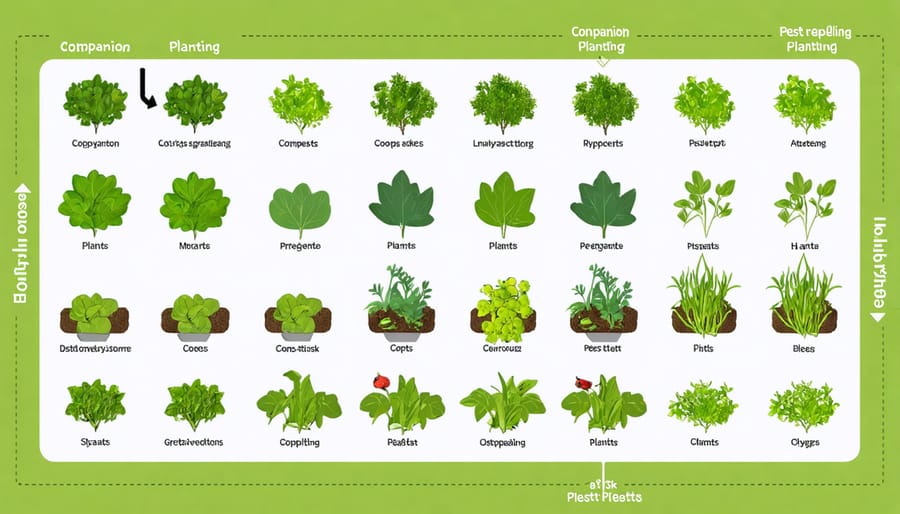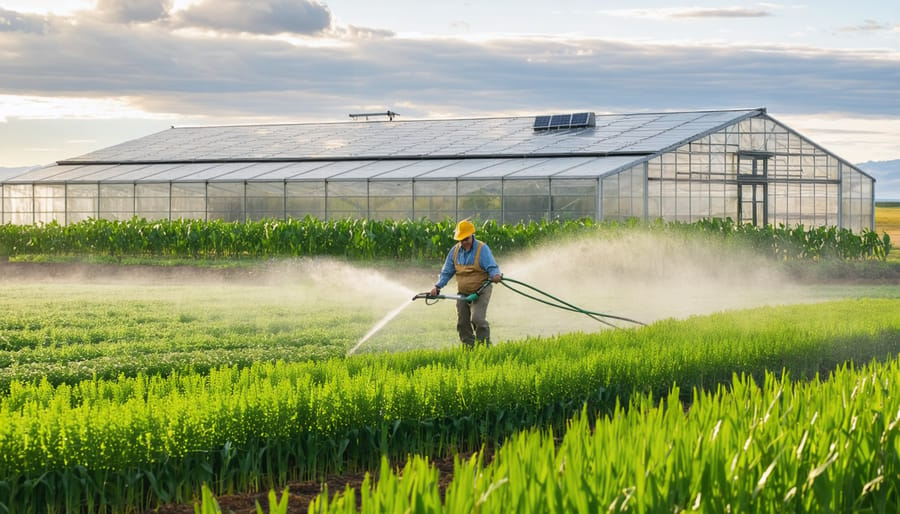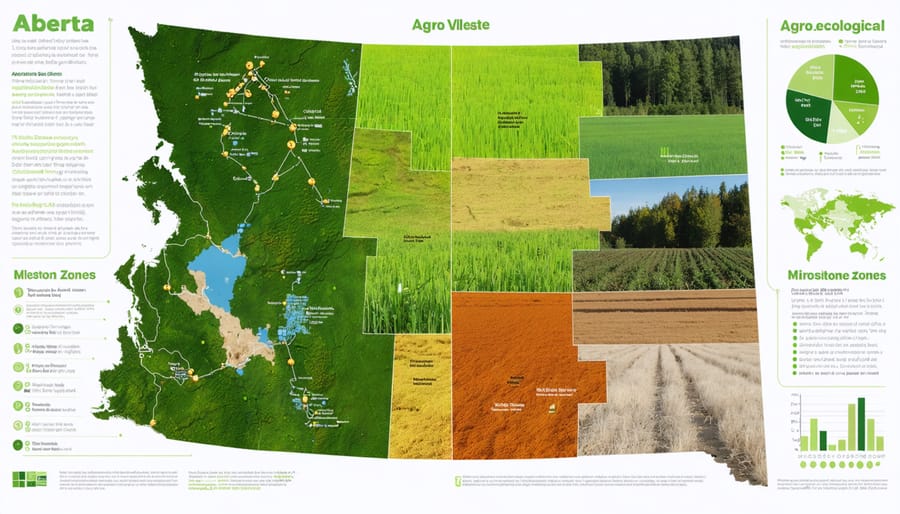Transform your property into a climate-ready sanctuary by implementing strategic pest control strategies and drought-resistant plantings. Plant deep-rooted native species like rough fescue and blue grama grass in clusters, creating natural wind barriers while reducing water needs by up to 50%. Install smart irrigation systems with soil moisture sensors, programming them to water during pre-dawn hours when evaporation rates are lowest. Establish three-zone landscaping – placing drought-tolerant plants farthest from buildings, moderate-water plants in transition areas, and creating moisture-retaining mulch beds near foundations. This practical approach helps Alberta properties withstand increasingly unpredictable weather patterns while maintaining aesthetic appeal and reducing maintenance costs throughout the growing season.
How Climate Change is Reshaping Alberta’s Pest Landscape
New Pest Patterns in Alberta’s Growing Zones
Recent climate shifts have significantly impacted pest patterns across Alberta’s growing zones, introducing new challenges for farmers and gardeners. We’re seeing earlier emergence of traditional pests like grasshoppers and flea beetles, often appearing 2-3 weeks ahead of historical patterns. New invasive species, including the Brown Marmorated Stink Bug and Japanese Beetle, are now establishing populations in regions previously too cold for their survival.
Monitoring data from local agricultural extension services shows that warmer winters have allowed pest populations to overwinter more successfully, leading to higher spring populations. Particularly concerning is the increased presence of wheat midge in northern regions and the expansion of pea leaf weevil territory into central Alberta.
Disease-carrying insects are also expanding their range, with aphid species now active an average of 15 days longer each season. This extended activity period not only impacts crop development but also increases the risk of virus transmission. Farmers are adapting by adjusting planting dates, implementing robust monitoring systems, and strengthening beneficial insect populations through habitat preservation.

Climate Impact on Pest Life Cycles
As Alberta’s climate continues to warm, we’re seeing significant changes in pest life cycles that directly impact our farms and gardens. Many insect pests are now surviving our milder winters in greater numbers, and warmer springs mean earlier emergence and longer breeding seasons. For example, grasshopper populations in Southern Alberta have shown increased survival rates during recent warmer winters, leading to higher spring populations.
These climate shifts are creating conditions where pests can complete multiple generations in a single growing season. What used to be a two-generation cycle for many insects is now often stretching to three or even four generations. Our local monitoring stations have recorded cabbage moths appearing nearly two weeks earlier than they did a decade ago.
Temperature increases also affect pest metabolism, leading to faster development and increased feeding rates. This means crops can face more intense pressure over longer periods. However, understanding these changes helps us adapt our management strategies. By tracking degree days and monitoring pest development more closely, we can better time our control measures and strengthen our integrated pest management approaches.
Strategic Landscape Design for Natural Pest Defense
Companion Planting Strategies
In Alberta’s diverse growing conditions, strategic companion planting offers a natural defense against common pests while promoting healthier soil and more resilient crops. Many local farmers have found success pairing aromatic herbs like dill and basil with their vegetable crops, as these plants naturally deter harmful insects while attracting beneficial pollinators.
For root vegetables, consider planting onions or garlic alongside carrots to ward off carrot rust flies. Marigolds aren’t just beautiful – they’re workhorses in the garden, protecting potatoes and other root crops from nematodes while adding splashes of colour. Indigenous Three Sisters planting (corn, beans, and squash) continues to prove effective in our climate, with corn providing support for climbing beans, while squash leaves shade the soil and suppress weeds.
Local success stories include the Bergstrom family farm near Red Deer, where interplanting calendula with tomatoes has significantly reduced hornworm damage. For brassicas like cabbage and broccoli, try surrounding them with aromatic herbs such as thyme or sage to confuse cabbage moths. Nasturtiums serve as excellent trap crops, drawing aphids away from your main produce.
When planning your companion planting strategy, remember to consider plant heights and growing seasons. Tall plants like sunflowers can provide afternoon shade for heat-sensitive crops during our intense summer days, while also supporting beneficial insects that help control pest populations naturally.

Buffer Zones and Barrier Plants
Strategic planting of buffer zones and barrier plants creates natural shields against extreme weather while supporting beneficial insects and deterring pests. In Alberta’s variable climate, farmers have found success with shelterbelts consisting of native conifers like white spruce and lodgepole pine, which provide year-round protection from harsh winds and help maintain soil moisture.
Consider planting tall grasses like Big Bluestem or Switchgrass along field edges, creating windbreaks that reduce soil erosion and protect vulnerable crops. These buffer zones also serve as habitat corridors for beneficial insects and birds that naturally control pest populations.
Alberta farmer Sarah Thompson implemented a diverse barrier system on her farm near Red Deer, combining drought-resistant shrubs with flowering perennials. “The barrier plants have significantly reduced wind damage to our market vegetables,” she reports, “and we’ve noticed increased pollinator activity since establishing these zones.”
For maximum effectiveness, arrange buffer plantings in multiple staggered rows, ensuring gaps between plants are minimal. This creates a more robust barrier while allowing for adequate air circulation to prevent disease issues in humid conditions.
Water Management for Pest Control
Smart water management plays a crucial role in discouraging pest populations while maintaining healthy soil conditions. In Alberta’s variable climate, implementing proper irrigation timing can significantly reduce pest pressure. Watering early in the morning, typically between 5 AM and 8 AM, allows plants to dry before evening, minimizing conditions that attract slugs and harmful fungi.
Creating proper drainage patterns through gentle slopes and strategic placement of water-loving plants helps prevent standing water, which can become breeding grounds for mosquitoes and other problematic insects. Many Alberta farmers have found success with drip irrigation systems, which deliver water directly to plant roots while keeping foliage dry.
Local farmer Sarah Thompson from Lacombe County shares, “Since switching to targeted irrigation and improving our drainage, we’ve seen a notable decrease in root rot and pest issues. It’s also helped us conserve water during dry spells.”
Consider installing French drains in areas prone to water accumulation and maintain proper spacing between plants to promote air circulation. These practices not only manage water effectively but also create an environment less hospitable to common agricultural pests.
Soil Health: Your First Line of Defense

Building Beneficial Microbe Communities
Building a thriving soil ecosystem is like cultivating a hidden garden beneath your feet. In Alberta’s diverse soil conditions, encouraging beneficial microbes can significantly boost your land’s resilience to climate fluctuations.
Start by minimizing soil disturbance – every time you till, you disrupt complex microbial networks. Instead, adopt no-till practices where possible and use cover crops to protect soil structure. Adding organic matter through compost and crop residues provides food for beneficial bacteria and fungi.
Local farmer Dave Johnston from Olds reports remarkable success using compost tea applications: “We’ve seen improved moisture retention and better nutrient cycling since implementing regular applications during the growing season.”
Consider incorporating mycorrhizal fungi when planting new areas. These fungi form beneficial partnerships with plant roots, expanding their reach for water and nutrients – particularly valuable during dry spells. You can purchase mycorrhizal inoculants or source them from healthy native areas on your property.
Rotate diverse crop families to support varied microbial populations. Include legumes, which partner with nitrogen-fixing bacteria to naturally enrich your soil. Avoid broad-spectrum fungicides and pesticides that can harm beneficial organisms.
Monitor your progress through simple soil tests and observation. Look for signs of healthy soil life: earthworms, fungal networks visible as white threads, and soil that crumbles easily with a sweet, earthy smell.
Organic Matter Management
Building healthy soil structure through effective organic management practices is your first line of defense against pest problems. Start by incorporating locally sourced compost and well-aged manure, aiming for an organic matter content of 3-5% in your soil. This creates a robust ecosystem that naturally suppresses harmful insects while supporting beneficial organisms.
In Alberta’s varying climate conditions, maintaining a year-round soil cover through green manure crops or cover crops is essential. Consider planting fall rye or winter wheat, which can add up to 4 tonnes of organic matter per hectare while protecting soil from erosion. These crops also break pest cycles naturally by preventing overwintering of common agricultural pests.
Crop residue management plays a crucial role too. Rather than removing or burning crop remains, incorporate them back into the soil using reduced tillage methods. This practice not only boosts organic matter but also provides habitat for beneficial insects that prey on pest species. Many Alberta farmers report success with leaving at least 30% residue cover on their fields.
Regular soil testing helps monitor organic matter levels and adjust your management strategy accordingly. Focus on building diverse soil food webs by rotating crops and avoiding synthetic pesticides that can harm beneficial soil organisms. Remember, healthy soil produces resilient plants that naturally resist pest pressure.
Seasonal Adaptation Strategies
Spring Preparation Techniques
As Alberta’s winters give way to spring, implementing effective pest prevention strategies becomes crucial for climate-smart farming practices. Start by conducting thorough field assessments in early March to identify overwintering pest populations and potential problem areas. Consider installing monitoring stations equipped with pheromone traps to track pest activity as temperatures rise.
Create natural barriers by maintaining diverse field edges with native flowering plants that attract beneficial insects. These helpful predators, such as ladybugs and parasitic wasps, serve as your first line of defense against harmful pests. Implement crop rotation plans that disrupt pest life cycles, particularly for common Alberta challenges like flea beetles and wheat midge.
For soil-dwelling pests, encourage healthy soil biology by incorporating cover crops and maintaining proper moisture levels. Apply compost tea or beneficial nematodes when soil temperatures reach 10°C to strengthen your soil’s natural defense systems.
Consider establishing trap crops around field perimeters to draw pests away from your main crops. Regular scouting sessions, ideally twice weekly during the critical spring emergence period, help identify and address potential issues before they become serious problems. Document your observations to build a seasonal pest management timeline specific to your farm’s conditions.
Remember that timing is everything – implementing these strategies before pest populations explode is key to successful organic pest management.
Winter Protection Methods
Winter in Alberta offers a crucial opportunity to get ahead of next season’s pest challenges while protecting your soil and beneficial organisms. Start by removing plant debris and fallen fruit that could harbor overwintering pests. However, leave some organic matter to protect beneficial insects that help control pest populations naturally.
Apply a thick layer of organic mulch around perennials and trees after the ground freezes, typically in late November. This not only insulates beneficial soil organisms but also prevents pest eggs from surviving in exposed soil. Many Alberta farmers have found success using locally sourced straw or wood chips, maintaining a 10-15 cm layer throughout winter.
Consider planting cover crops like fall rye or winter wheat in September. These crops suppress weed growth and create natural barriers against pest establishment while improving soil structure. As shared by Doug Miller, a third-generation farmer near Red Deer, “Winter cover cropping has reduced our spring pest problems by about 40% while building healthier soil.”
Install physical barriers like tree wraps and fencing before the first frost to prevent damage from rodents seeking winter shelter. Remove snow from tree bases to discourage mouse and vole activity. Remember to monitor your winter protection methods regularly, especially after significant weather events, to ensure they remain effective throughout the season.
As we’ve explored throughout this guide, climate-responsive landscaping isn’t just about adapting to change – it’s about creating resilient and sustainable agricultural spaces that work with nature, not against it. Here in Alberta, we’re already seeing farmers successfully implementing these strategies, from windbreaks that protect crops from increasingly extreme weather to water-wise irrigation systems that conserve our precious resources.
The key to success lies in starting small and scaling up gradually. Consider beginning with a single strategy, such as incorporating drought-resistant native plants or implementing a basic water management system. As you become comfortable with these changes, you can expand your approach to include more comprehensive solutions.
Remember, you’re not alone in this journey. Our agricultural community is built on sharing knowledge and supporting one another. Connect with local agricultural extension services, join farmer-led discussion groups, and participate in field days to learn from others’ experiences and share your own.
The future of farming in Alberta depends on our ability to adapt and innovate. By implementing climate-responsive landscaping techniques, we’re not just protecting our farms – we’re building a more resilient agricultural future for generations to come. Take that first step today, whether it’s designing a new drainage system or planting your first windbreak. Every positive change, no matter how small, contributes to the bigger picture of sustainable agriculture in our region.







